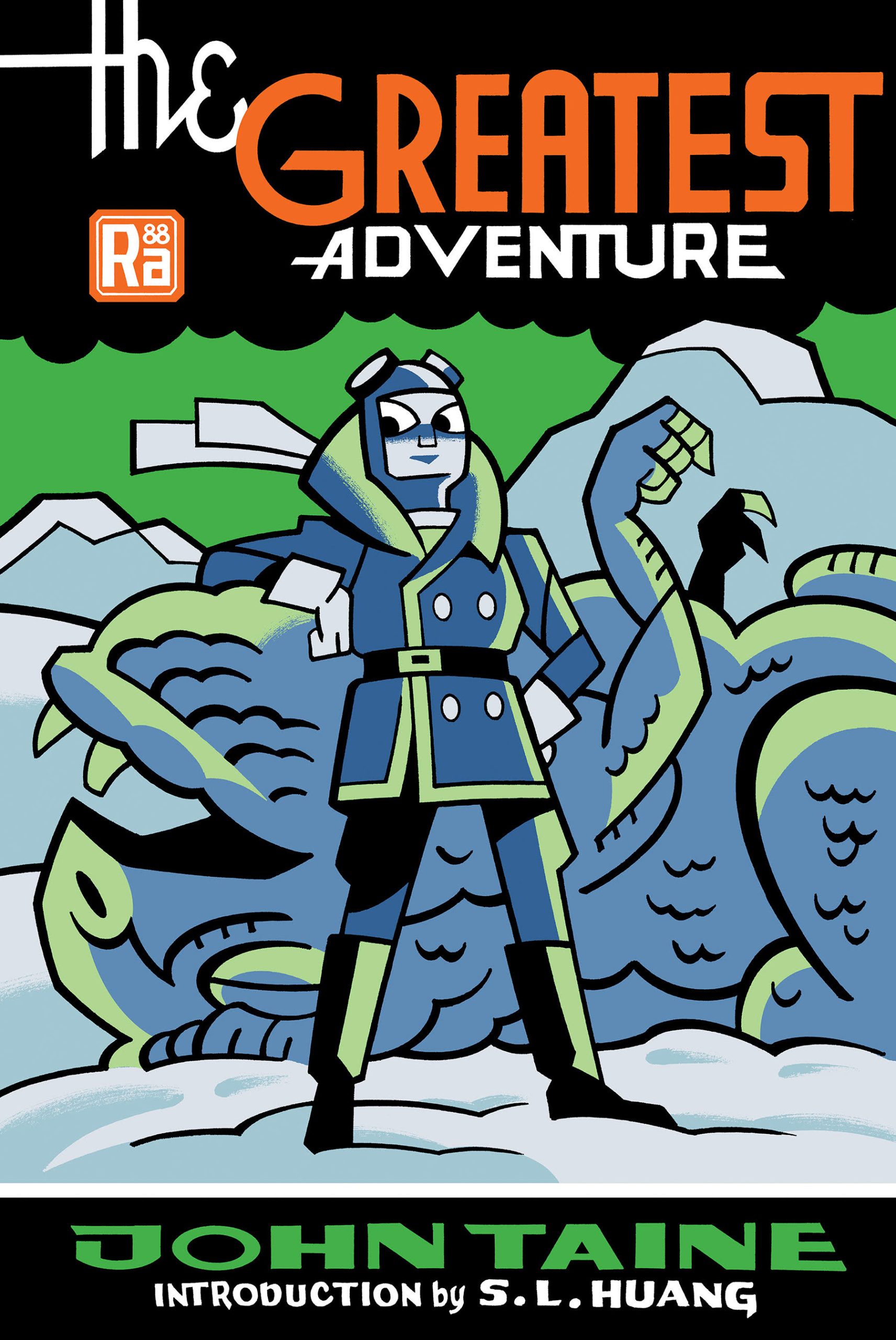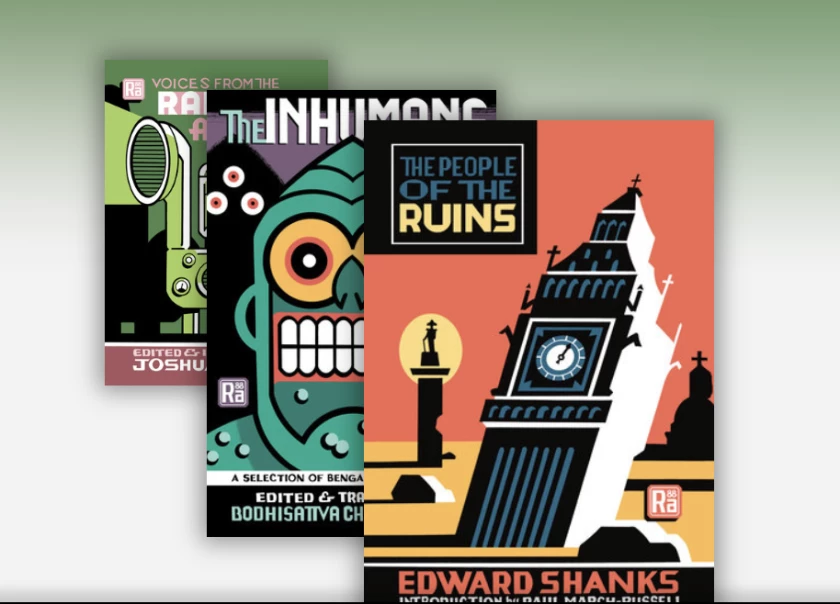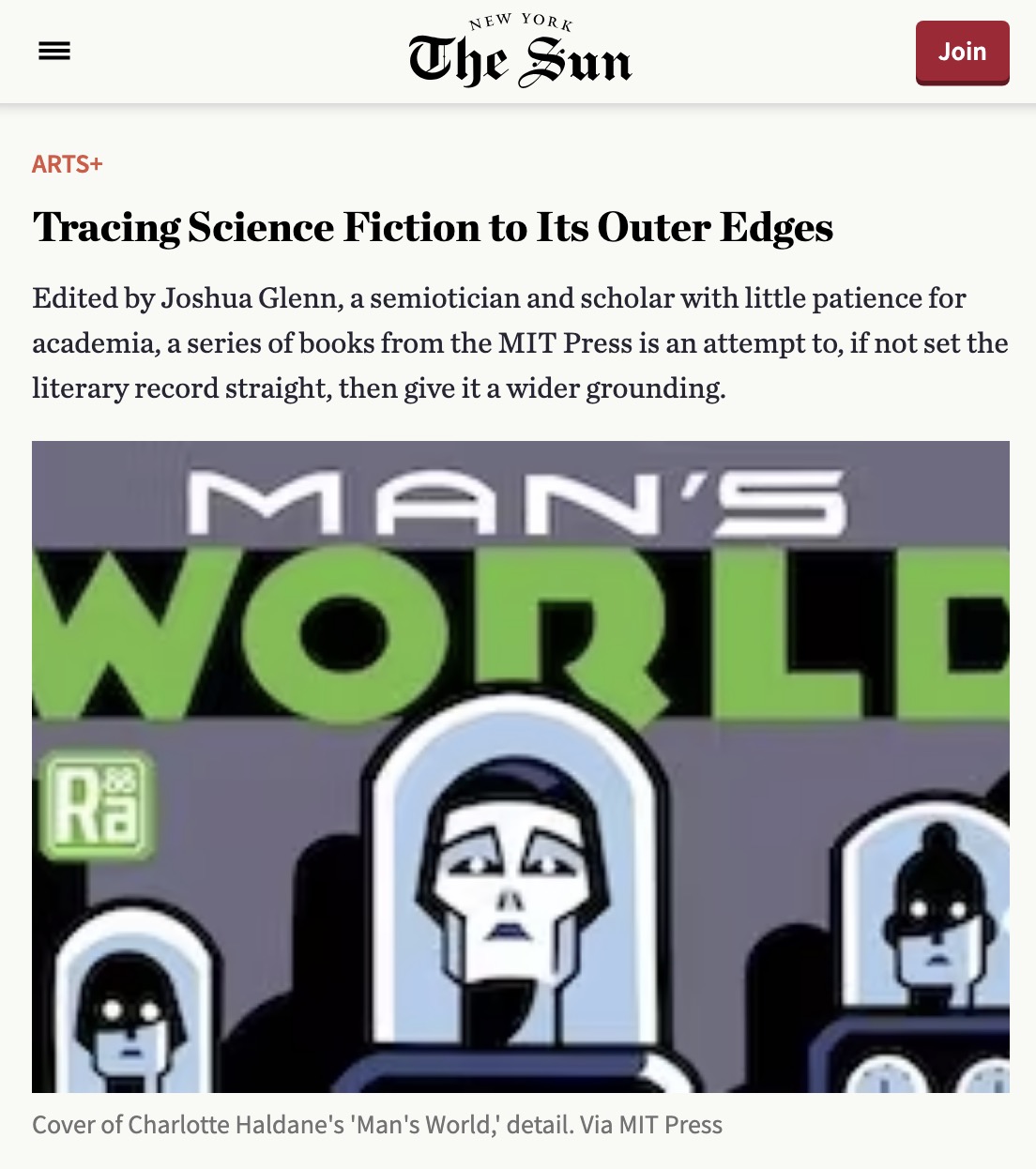RADIUM AGE 2Q2024
By:
June 28, 2024

Under the direction of HILOBROW’s Josh Glenn, in 2022 the MIT Press launched its RADIUM AGE series of proto-sf reissues from 1900–1935.
In these forgotten classics, sf readers will discover the origins of enduring tropes like robots (berserk or benevolent), tyrannical supermen, dystopias and apocalypses, sinister telepaths, and eco-catastrophes. With new contributions by historians, science journalists, and sf authors, the RADIUM AGE book series recontextualizes the breakthroughs and biases of these proto-sf pioneers, and charts the emergence of a burgeoning literary genre.
RADIUM AGE SERIES UPDATES: 2022 | 2023 | 2024 | 1Q2025 | 2Q2025. FULL SERIES INFO.
Below, please find updates on the RADIUM AGE project from 2Q2024.

During 2Q2024, Josh worked with the MITP’s Noah Springer to pitch four 2026 titles to the editorial board, and to assign introductions for those 2026 titles that were approved.
He also worked with the MITP editorial team to copy edit our Spring 2025 titles: J.D. Beresford’s The Hampdenshire Wonder (with a new introduction by Ted Chiang) and John Taine’s The Greatest Adventure (with a new introduction by S.L. Huang). More info on these two titles, along with Seth’s terrific illustrations, can be found here.
Josh also advanced the series’ two Fall 2025 titles towards the production stream: Marietta Shaginyan’s Mess–Mend, translated and introduced by Jill Roese, plus a superhuman-themed collection of stories and excerpts, edited by Josh.
Also…

Here at HILOBROW, Josh has continued to share his Radium Age-related research. For example, via the series RADIUM AGE POETRY and RADIUM AGE ART, he’s shared proto-sf-adjacent poems and art works from the years 1900–1935.
Here’s the 2Q2024 RADIUM AGE ART lineup:
1909 | 1910 | 1911 | 1912 | 1913 | 1914 | 1915 | 1916 | 1917.
And here’s a sampling of the 2Q2024 RADIUM AGE POETRY lineup:
Kenneth Rexroth’s “HEAVEN IS FULL OF DEFINITE STARS…” | Leslie Pinckney Hill’s ARMAGEDDON | Wallace Stevens’s THE IDEA OF A COLONY | Adele Gloria’s EXPRESS TRAIN NO. 89 | Valery Bryusov’s THE DAYS SHALL COME OF FINAL DESOLATION | W.H. Auden’s GARE DU MIDI | D.H. Lawrence’s THE GULF.
To see the full RADIUM AGE POETRY lineup, visit this page.

Here at HILOBROW, as we have been doing for a decade now, during 2Q2024 we serialized some of Josh’s favorite Radium Age proto-sf stories and novels. Here’s the lineup:
- Van Tassel Sutphen’s The Doomsman (1905–1906)
- Rudyard Kipling’s “Unprofessional” (1930)
- Irene Clyde’s Beatrice the Sixteenth (1909)
Here’s what they’re saying about the series:
“Joshua Glenn’s admirable Radium Age series [is] devoted to early- 20th-century science fiction and fantasy.” — Michael Dirda, Washington Post | “Neglected classics of early 20th-century sci-fi in spiffily designed paperback editions.” — The Financial Times | “New editions of a host of under-discussed classics of the genre.” — Tor.com | “The best proto-science fiction novels and stories from 1900 to 1935.” — The Washington Post. | “Long live the Radium Age.” — Scott Bradfield, Los Angeles Times | “Shows that ‘proto-sf’ was being published much more widely, alongside other kinds of fiction, in a world before it emerged as a genre and became ghettoised.” — BSFA Review. | “A huge effort to help define a new era of science fiction.” — Transfer Orbit | “It’s an attractive crusade. […] Glenn’s project is well suited to providing an organizing principle for an SF reprint line, to the point where I’m a little surprised that I can’t think of other similarly high-profile examples of reprint-as-critical-advocacy. ” — The Los Angeles Review of Books | “An excellent start at showcasing the strange wonders offered by the Radium Age.” — Maximum Shelf

During 2Q2024, the Radium Age series received some nice attention. We were particularly gratified to read Bodhisattva Chattopadhyay’s response to a question about the series in an interview with the sf magazine Strange Horizons:
The Radium Age is a fantastic project, and I am so glad that The Inhumans is part of the series. I am really quite fond of early science fiction, but I don’t see these works as dated or old, especially when it comes to their relevance. The themes that we find in late 19th and early 20th century science fiction are also the themes of the here and now. Take something like Everett Bleiler’s two fantastic bibliographic studies, Science Fiction: The Early Years, and Science Fiction: The Gernsback Years. Now if you look at Bleiler’s classification of the themes, whether those are outer space adventures or genetic engineering, advanced weapons or robotics, you find it all already in science fiction of the period. We often talk about the “predictive quality” of science fiction, and even if science fiction writers do not necessarily set out to be predictive, the genre has often been remarkably prescient when it comes to technological futurism and epistemological futurism, two concepts that I developed to talk about science fiction’s speculative drive: that is imagining future technological change as well as the change in the underlying knowledge structures driving technological change. Resources like Technovelgy have been documenting things such as this for a while. So there’s one excellent reason to dive into early science fiction in any case.
But what makes the early period more fascinating is not just this kind of prescience, but the way it deals with the embeddedness of the technological in the social, and the social impact of change itself. And all this is written beautifully, and simply — in the mix of genres that does not privilege one register or style of storytelling over another, where making the story intelligible is paramount. Because these stories are a way of sensemaking during a senseless time. The Radium Age is a crazy period, because these technological changes and discoveries are happening at a time of incredible social upheaval. War – and the threat of nuclear war — leading to total annihilation of humanity is the mood. Science fiction captures this devastation, this dystopia, this pessimism, while offering a refreshing possibility of change. Hence the Radium Age books.
We are now living in the same times — if anything somewhat worse. We are 90 seconds to midnight, and we have never been closer. Governments are going back on war footings. Identities that had been ostensibly and forcibly contained within nation state boundaries are showing their embeddedness in intra- and trans-national units. Democratic backsliding defines the politics of our present. And to add to these is climate change, which will get us all. And again people are turning to science fiction, for both the image of despair and the possibility of transformation. This is happening globally, because science fiction — by whatever name we choose to call it — has always been global.
So if we look at the volumes in the Radium Age series, we quickly see how relevant these books are, and continue to be. There’s dystopia, there’s totalitarianism, there’s nuclear war, there’s population control, there’s violent nationalism. But there’s also love, and resistance, and hope and humor. So we are very much in the same space as these books now in our present. And these books, if anything, often tell us more about where we are now in our current societal development compared to contemporary science fiction, which tries to imagine our far tomorrows. The Inhumans definitely tells us something about colonial Bengal and India, but it is also very much a book of the now. I think there are so many things we are yet to understand about early science fiction.
Bodhisattva was being interviewed about one of our latest titles, The Inhumans and Other Stories), a collection of stories that he selected and translated from Bangla.
Here’s a sampling of additional 2Q2024 series publicity:
- Josh was interviewed about the series on the NPR (KPCW) show COOL SCIENCE RADIO. The episode aired on April 4th.
- The conservative newspaper New York Sun published a story on the series, on April 11. Excerpt: “Edited by Joshua Glenn, a semiotician and scholar with little patience for academia, a series of books from the MIT Press is an attempt to, if not set the literary record straight, then give it a wider grounding.” Also: “The cover designs for the series are the work of Gregory Gallant, better known as Seth. His illustrations achieve an eye-grabbing balance between the futuristic and the retro.” About The Inhumans: “Mr. Chattopadhyay divines anti-colonialist sentiment within Roy’s satirical take on the strictures of civilization.” About Man’s World: “A dystopian conundrum and an alarming read.”
- Writing for Locus (the March print issue; published online on April 14), Niall Harrison had the following to say about our translation of The Inhumans. “For about 15 years now, Joshua Glenn has been banging the drum for the historical and literary value of ‘proto-SF’ published between roughly 1900 and 1935. […] The historical parallax provided by a book such as The Inhumans is, for me, where the full potential of the [Radium Age] project shines through.”
- “By presenting four pieces originally written in Bangla and here translated into English for the first time, the book demonstrates that the Radium Age was a truly global phenomenon.” | “For a book so full of experiments gone wrong, the inclusion of The Inhumans and Other Stories in the Radium Age series feels utterly right.” — Strange Horizons
- In June, Strange Horizons also published an interview with Bodhisattva Chattopadhyay about The Inhumans and Other Stories. Excerpt: “With Bangla SF there’s a further twist here: the modern scientific enterprise, with its professional scientist class, its technical instruments and infrastructure, its claims to reason and objective pure knowledge, is largely seen as a European or colonial import. And it works at times and doesn’t work at others, it’s imperfect and incomplete, so there’s plenty there that’s already suspect despite a claim to objectivity and truth, which is generally a source of amusement. Poking fun at those who take themselves too seriously, or those who are higher in the hierarchy, is a favorite pastime of Bengalis…”
- “A brilliant series…. The books feature new introductions, text unfettered by notes, and striking cover art by Canadian cartoonist Seth, featuring a strong variety of works, including female and under-represented authors of color.” — Ancillary Review of Books (June)
Plus, this:

MORE RADIUM AGE SCI FI ON HILOBROW: RADIUM AGE SERIES from THE MIT PRESS: In-depth info on each book in the series; a sneak peek at what’s coming in the months ahead; the secret identity of the series’ advisory panel; and more. | RADIUM AGE: TIMELINE: Notes on proto-sf publications and related events from 1900–1935. | RADIUM AGE POETRY: Proto-sf and science-related poetry from 1900–1935. | RADIUM AGE 100: A list (now somewhat outdated) of Josh’s 100 favorite proto-sf novels from the genre’s emergent Radium Age | SISTERS OF THE RADIUM AGE: A resource compiled by Lisa Yaszek.




